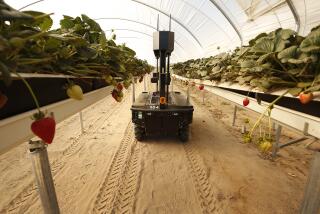Organic agriculture attracts a new generation of farmers

According to the agriculture census, the average age of farmers in the U.S. is reaching retirement age. However, for the first time in generations a growing number of young men and women are taking up farming for a living.
By 9 a.m., Jack Motter had been planting peas for hours.
He pushed a two-wheeled contraption that deposited a seed every few inches along neat rows at Ellwood Canyon Farms, just outside Santa Barbara. As clouds gathered overhead, he picked up the pace to avoid losing days of work to the fall rain.
Timing can mean the difference between profit and loss for the 4-year-old farm.
Motter and his business partner, Jeff Kramer, are part of a growing crop of farmers — many of them young — choosing to produce food without pesticides and synthetic fertilizers. As consumers demand more fresh and local food grown with minimal environmental effects, a new generation has taken up organic farming.
The two Brawley, Calif., natives, both 30, have learned that small-scale agriculture is neither easy nor lucrative. Their days on the 15-acre farm start at dawn and end with exhaustion.
“There’s nothing romantic about it,” Kramer said. “It’s hard work and long hours for little pay.”
Agriculture officials are hoping more young people heed the call to till the land, whether organically or conventionally, as the average age of California farmers continues to climb. It hit 58 in 2012, up by nearly two years from 2007, according to the U.S. Department of Agriculture’s most recent census.
In 2012, the number of California farmers 65 and older grew nearly 20% to 39,428 during the five-year period — nearly three times faster than farmers ages 25 to 34.
Older agricultural operators outnumber their younger counterparts 6 to 1, the data show. There are fewer than 6,400 farmers ages 25 to 34 in California.
Agriculture trade groups have developed programs, including training and financial incentives, aimed at attracting young people. The National Young Farmers Coalition through member surveys has found that the bulk of new operators are going the organic route.
Many new farmers are motivated primarily by the desire to show that mainstream methods aren’t the only way to grow food.
Large conventional farms can churn out commodity crops quickly and economically. The average American farm, tilled by heavy machinery, is now 434 acres, up from 418 in 2007, the USDA reported recently.
But changing consumer preferences for locally grown and organic food have paved the way for young farmers to carve out a niche.
Chris Velez is among them. About 300 miles north of Ellwood Canyon Farms, Velez has spent nearly 10 years farming five acres in Auberry, Calif. He sees the work as a mission.
“The Earth is in a pretty dramatic state,” he said. “It’s truly calling for people to come tend to the land in a healthy way.”
The 38-year-old has taken on apprentices to learn the trade. Farm interns have spent a couple of months at Stella Luna Farm, named after Velez’s 13-year-old daughter, Stella.
Starting a small farm poses big challenges. Large amounts of capital are needed for land and equipment, but novice farmers have a tough time securing lines of credit. Banks don’t see big profits.
Velez and others, however, have found creative ways to get their farms going.
Kramer and Motter, for instance, borrow equipment from farmer neighbors and look for deals on used tractors and attachments on Craigslist. Velez and his wife, Jamie Carr, live frugally and avoid going into debt. Growing their own food helps.
We “might be poor on paper, but farming allows for spending time with kids,” said the father of two. “My richness is life.”
Indeed, in this small community of 2,400 an hour south of Yosemite National Park, the kids, Stella and Cosmo, 8, ride their bikes up and down the lane near their home and farm. Velez is often home but usually working.
Only recently has Velez learned to pace himself. For years, he worked from sunup to sundown. In 2004, he ran a nursery and simultaneously farmed the five acres before buying the land in 2007.
Now, he said, he will take much-needed breaks. That usually involves having a few beers while watching either of his two favorite soccer teams, the Mexican national team and Manchester United.
Carr, who works as an organic farm inspector, pitches in around the farm when not traveling for her job.
Velez has structured his business around a CSA, or community-supported agriculture operation. His more than 60 customers pay up to $840 at the beginning of the growing season and receive a weekly box of produce for 42 weeks. That works out to $20 a box.
He also started selling seed transplants and flowers at a Fresno farmers market recently to generate more income.
Velez, with long, thick dreadlocks and a love for Bob Marley, acknowledges that he doesn’t look like a typical farmer, but get him going on growing food and he can spend hours talking about vegetables.
He’s gained more confidence over the years, but the former city dweller said farming is full of challenges.
Gophers and other wildlife will snack on his carrots, weeds will crop up in his neat rows of produce. And, of course, farmers are always at the mercy of the weather. Velez lost a whole crop of peppers and tomatoes to a late fall frost.
But they are helped by growing demand. Though organic produce sales account for less than 1% of the total value of food grown in the U.S, the share is increasing. New data show that sales of organically farmed food jumped nearly 84% in 2012 from 2007, reaching $3.12 billion, according to the USDA.
Chris and Johanna Finley of Santa Ynez got their start just as the organic food movement gained traction.
“We already had our foot in the door,” Johanna Finley said. “The trend played right into our favor.”
Chris, 36, and Johanna, 35, were students at UC Santa Barbara working part time at a local farmers market. After a short stint selling homemade salsa, they decided to go into farming in 2002.
They started small, leasing an acre of land on the Gaviota coast just north of Goleta. The land, however, lacked easy access to water and was on a hillside. The novice farmers found the hill treacherous to navigate with a tractor.
“We taught ourselves everything we know,” Johanna Finley said.
Eventually, the Finleys signed a lease for property in the Santa Ynez Valley, a famed wine-growing region northwest of Santa Barbara. Leasing is typically cheaper than buying farmland, the price of which has skyrocketed in recent years. Farmland prices in California topped an average of $7,300 an acre last year, according to the USDA.
As the couple have matured, so has the business. Finley Farms now has sales of about $700,000 annually. They operate two farms on 60 acres: the 10-acre home farm where they live, and 50 acres of leased land about five miles away.
The success has been validating. Starting out, the couple never anticipated farming that much land and employing 11 people.
Meanwhile, Motter and Kramer have yet to see a profitable year. But sales are steadily growing.
The pair, lifelong friends who grew up in the Imperial Valley, where their families have farmed conventionally for decades, are determined to make the farm work.
“A system has been designed around a certain way of agriculture and a reliance on cheap fossil fuels and availability of cheap fertilizers, and those things are changing,” Kramer said. “We’re the next generation. It’s on us.”
More to Read
Inside the business of entertainment
The Wide Shot brings you news, analysis and insights on everything from streaming wars to production — and what it all means for the future.
You may occasionally receive promotional content from the Los Angeles Times.











